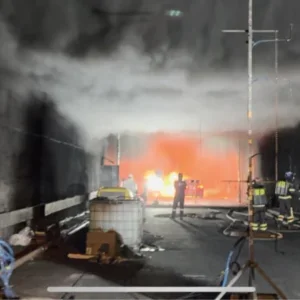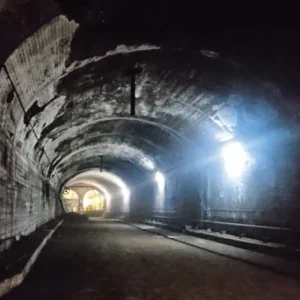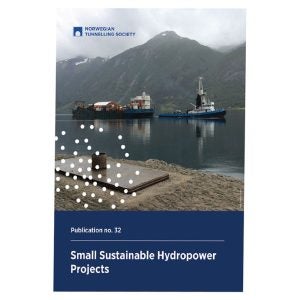The 4.55m o.d., 4.15m i.d. primary lining for the ECIS contract requires the casting of 60,000 linear ft (18,288m) of bolted and gasketed reinforced concrete segments with six segments/ring and three different ring types – two 1.524m rings – one straight, one tapered – and a shorter 1.372m tapered ring.
When preparing its tender, the Kenny/Shea/Traylor/Frontier Kemper JV invited four groups to quote for supply of the ECIS lining. Of these, a separate and independent joint venture company between Traylor and Shea submitted the most competitive offer producing the segments at a new high-tech casting facility in Palmdale, 60 miles north-east of Los Angeles. “The facility was established primarily for the ECIS project,” said Mehdi Ghazi, plant manager, “but also with the NEIS and Arrowhead projects in mind. We submitted competitive bids for these projects and the groups in which we are listed as the precast segment supplier are lowest bidder and are in the process of being awarded the contracts. As such we are now responsible for supplying more than 130,000ft (about 25 miles (40km)) or about $90 million of segmental lining to these projects over the coming 2-3 years.”
With the initial ECIS contract in hand, the JV (with Ghazi as a JV partner in the NEIS and Arrowhead contracts) decided that the casting yard would be state-of-the-art and comprise two steam curing production carousels.
The two production lines, each housed in its own shed and served by its own dedicated batching plant, comprise 72 segment moulds (144 total) procured from CBE of France. CBE also supplied the carousels, the vacuum demoulding hoist, the rig for turning the segments, and another to compress the sealing gasket into the segment groove. Demag of San Bernardino supplied gantry cranes for moving materials through the plant.
The two batching plants are imported from Kabag Wiggert of Germany via its US distributor Advanced Concrete Technologies in New Hampshire. Each is fully automated and fitted with a 2yd³ counter-current planetary pan mixer.
Both carousels, and the batching plants, are fully PLC controlled (programmable logic controlled). From a console in the control room of the batching plant, the data for various mixes and different batch volumes are entered. This is linked electronically to the console of the mould-filling operator who, at the press of a button, calls for whichever volume and mix is needed next.
Once each prepared mould is ready for filling it moves into an acoustically enclosed filling station where a set of four small air bladders inflate to lift the mould off the carousel rails and allow efficient action of the two integrated vibrators as the fly hopper discharges. The filled mould then passes on to workstations where the back is troweled manually and the top wing panels are lifted slightly to ensure adequate circulation in the steam-curing tunnel.
There are four carousel channels through the 140ft long curing tunnel. As each segment leaves the tunnel, the PLC system moves the next into the same channel at the top end.
Steam is generated for both production lines by a single natural-gas direct-fired generator supplied by Welden of the US. The flame in the top of the boiler heats the water directly to generate steam of up to 200°F. There are three climate zones in the curing tunnel and steam is fed to each via sensor-operated valves. Segments spend about 71/2h in the curing tunnel to reach the 2,000psi strength required for demoulding. The 6,000psi 28-day strength is reach after another seven days or so.
“When all four TBMs for ECIS are running, we will need to be shipping about 60 rings/day (360 segments) at peak,” said Chris Hebert, assistant plant manager. When T&TNA visited the plant in early April, there were about 2,500 rings (15,000 segments) in the ring-set stockpiles.
The tunnel site in Los Angeles is a trip of about 1h one way, but the Palmdale location was chosen specifically. It is close to several aggregate quarries and to the Cemex cement facility in Victorville and the area provided for ample space for lease at reasonable rates. Construction of the factory started in July 2001 and segment casting started in October.
To meet the ECIS production schedule of 48 rings/24h, the plant operates two 81/2h shifts with the crews completing a full 72-mould cycle/shift/production carousel.
The sealing gaskets for the segmental lining is imported from Phoenix of Germany and the bolting systems are imported from the UK. Straight bolts from Ashley Forge connect the radial joints and the Buclock system from C. V. Buchan is used on the circle joints. Cages of reinforcement are assembled at the plant from prefabricated parts delivered by subcontractor Pacific Reinforcing.
Quality control and tolerances at the plant are strict. Mould tolerance for width for example is 0.3mm. The plant is ISO 9001 certified and there are full time quality control engineers on staff for each shift.
Once production of the ECIS order nears completion the factory will be prepared with new moulds for the NEIS and Arrowhead projects.






